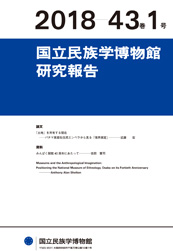Bulletin of the National Museum of Ethnology
CONTENTS
- Articles
- The Actual as Possessing the Land: Demarcation from the Perspective of the Embera (Panama)
Kondo, Hiroshi - Research Resources
- Inaugural Address on the Occasion of the 40th Anniversary of the Opening of the National Museum of Ethnology
Yoshida, Kenji - Museums and the Anthropological Imagination: Positioning the National Museum of Ethnology, Osaka on its Fortieth Anniversary
Shelton, Anthony Alan
Outline
Articles
The Actual as Possessing the Land:
Demarcation from the Perspective of the Embera (Panama)
Hiroshi Kondo*
Indigenous political movements in the late 20th century have brought positive results in the recognition of land rights throughout their territory, along with its demarcation. However, some anthropologists, especially those who specialize in studies of indigenous people in lowland areas of South America, have raised questions about the fruits of the political movements in terms of continuity between the idea of demarcation and indigenous ways of life. Based on this perspective, this article presents a discussion of what situations emerge in the social life of the Embera, an indigenous people of Panama, newly introducing the land boundary idea. Boundaries of two kinds are discussed in this article: one is that of a regional administrative division as a fruit of recognition of land title for the Embera; the other is that of demarcating individually possessed plots. Specifically examining its efficacy of exclusion, the author describes some particularities of these boundaries, which are also related to the question of the property relationship. This examination leads us to ascertain that a new form of morals related to land use has emerged among the Embera.
1 本稿の問いと視点
1.1 先住民の権利と土地の境界画定
1.2 境界線という主題
1.3 所有に関する人類学的議論
2 調査対象について
2.1 先住民エンベラについて
2.2 特別区制度
2.3 調査地の概要
3 二つの境界線
3.1 特別区の境界線
3.2 区画の境界線
3.3 囲い込まれない土地
4 土地利用における境界線
4.1 土地利用の仕方
4.2 土地所有のための境界線
4.3 線としての区画
4.4 排除による所有
5 継承と利用
5.1 批判される継承
5.2 利用なき継承
6 二つの所有関係
6.1 所有の持続性
6.2 継承の前提としての利用
6.3 行為による所有
7 二つの所有枠組みの関係性
7.1 〈作物〉と〈土地〉
7.2 物質性への/からの作用
7.3 排除の作用をうけない運動
7.4 コロノを排除しない境界線
8 結論 新しい道徳を開くための境界線
* 立命館大学
Key Words:Embera, property, indigenous rights, demarcation, exclusion
Research Resources
Inaugural Address on the Occasion of the 40th Anniversary of the Opening of the National Museum of Ethnology
Kenji Yoshida*
* 国立民族学博物館長
Key Words:National Museum of Ethnology, ethnographic collection, forum, fieldwork
Museums and the Anthropological Imagination: Positioning the National Museum of Ethnology, Osaka on its Fortieth Anniversary†
Anthony Alan Shelton*
1 Scientific Anthropology and the Birth of Ethnographic Museums
2 The Origins of Critical Anthropology and Museological Resistance
3 Scientific and Critical Anthropology in the History of MINPAKU
4 Challenge and Change: MINPAKU and the ‘Anthropological Imagination'
† Speech on the Occasion of the 40th Anniversary of the Opening of the National Museum of Ethnology
* University of British Columbia, Vancouver
Key Words:museums, MINPAKU, anthropological imagination, museology, histories
 2018-Vol. 43, No. 1
2018-Vol. 43, No. 1




